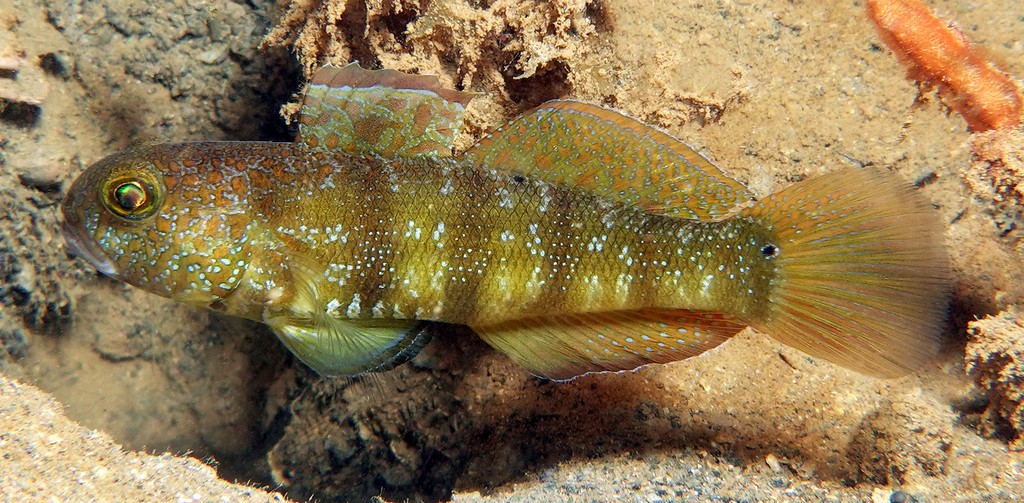AMBLYGOBIUS SPHYNX - (VALENCIENNES, 1837)
Picture courtesy of: Yves Thévenet
Gobie sphynx, Sphynx goby, Sphinx goby, Sfinks-dikkop, Sufinkususarasa-haze, スフィンクスサラサハゼ, 蛾鈍鰕虎魚,
Synonymes
Ambligobius sphynx (Valenciennes, 1837)
Apocryptes fasciatus (Macleay, 1883)
Gobius deilus (Sauvage, 1880)
Gobius rubrotaeniatus (Günther, 1861)
Gobius rubrotaeniatus (Liénard, 1891)
Gobius sphynx (Valenciennes, 1837)
Gobius stagon (Smith, 1947)
----------------------------
Description
Dorsal spines (total): 7; Dorsal soft rays (total): 13-15; First dorsal fin low and rounded; Anal spines: 1; Anal soft rays: 13-15; Pectoral fin rays: 17-19; Lateral line scales: 46-52; Longitudinal scale series: 55; Depth of body: 3.6-4.0 in SL. First and second dorsal fin equal in height; Rounded caudal fin; Ctenoid body scales; Cycloid scales on nape, abdomen, and breast; Predorsal scales extending to interorbital space; Scales dorsally on opercle, absent on cheek. Max. length: 18.0 cm TL. Depth range: 1 - 20 m.
Color
A yellowish-brown goby becoming white below with 5-6 dark brown bars separated by white markings along the side, and a row of small widely spaced black spots along the back.
Etymology
Amblygobius: from Greek, amblys or amblus = dull (blade: not sharp), blunt, obtuse + from Latin, gobius = gudgeon. Referring to compressed, convex and blunt head of Amblygobius sphynx.
sphynx: etymology not explained. From Latin, sphinx = a creature with the head of a person and the body of an animal (commonly a lion). Or for its sphynx moth-like coloration or appearance.
Original description: Gobius sphynx Valenciennes, 1837 - Type locality: New Guinea.
Distribution
Red Sea, Indo-West Pacific: East Africa, Comoros, Madagascar and Mascarenes east to Palau and New Ireland (Papua New Guinea), north to Yaeyama Islands (Japan), south to northern Australia and New Caledonia.
Actinopterygii (Gigaclass) > Actinopteri (Class) > Teleostei (Subclass) > Gobiiformes (Order) > Gobioidei (Suborder) > Gobiidae (Family) > Gobiinae (Subfamily) > Amblygobius (Genus)
Gobie sphynx, Sphynx goby, Sphinx goby, Sfinks-dikkop, Sufinkususarasa-haze, スフィンクスサラサハゼ, 蛾鈍鰕虎魚,
Synonymes
Ambligobius sphynx (Valenciennes, 1837)
Apocryptes fasciatus (Macleay, 1883)
Gobius deilus (Sauvage, 1880)
Gobius rubrotaeniatus (Günther, 1861)
Gobius rubrotaeniatus (Liénard, 1891)
Gobius sphynx (Valenciennes, 1837)
Gobius stagon (Smith, 1947)
----------------------------
Description
Dorsal spines (total): 7; Dorsal soft rays (total): 13-15; First dorsal fin low and rounded; Anal spines: 1; Anal soft rays: 13-15; Pectoral fin rays: 17-19; Lateral line scales: 46-52; Longitudinal scale series: 55; Depth of body: 3.6-4.0 in SL. First and second dorsal fin equal in height; Rounded caudal fin; Ctenoid body scales; Cycloid scales on nape, abdomen, and breast; Predorsal scales extending to interorbital space; Scales dorsally on opercle, absent on cheek. Max. length: 18.0 cm TL. Depth range: 1 - 20 m.
Color
A yellowish-brown goby becoming white below with 5-6 dark brown bars separated by white markings along the side, and a row of small widely spaced black spots along the back.
Etymology
Amblygobius: from Greek, amblys or amblus = dull (blade: not sharp), blunt, obtuse + from Latin, gobius = gudgeon. Referring to compressed, convex and blunt head of Amblygobius sphynx.
sphynx: etymology not explained. From Latin, sphinx = a creature with the head of a person and the body of an animal (commonly a lion). Or for its sphynx moth-like coloration or appearance.
Original description: Gobius sphynx Valenciennes, 1837 - Type locality: New Guinea.
Distribution
Red Sea, Indo-West Pacific: East Africa, Comoros, Madagascar and Mascarenes east to Palau and New Ireland (Papua New Guinea), north to Yaeyama Islands (Japan), south to northern Australia and New Caledonia.
Biology
Solitary or in pairs. Occurs on sandy or sparse seagrass substrata of protected reefs. Hovers just above the bottom and takes refuge in a burrow. Feeds mostly on small crustaceans and gastropods, sifted from mouthfuls of sand.
Solitary or in pairs. Occurs on sandy or sparse seagrass substrata of protected reefs. Hovers just above the bottom and takes refuge in a burrow. Feeds mostly on small crustaceans and gastropods, sifted from mouthfuls of sand.
Last update: 6, May 2022
